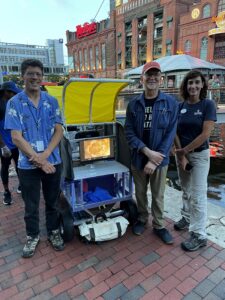
Bio-Buggy is a mobile art and science laboratory on wheels designed and envisioned by Stephen Bradley and Dr. Eric Schott. The goal of the Bio-Buggy is to increase the connection that urban residents feel for the living resources in nearby estuaries that they both enjoy and affect. The buggy also serves as a scientific platform to collect video data on the biodiversity of the estuary. The data collection function is intended to enhance public engagement and invite their participation in the science of estuary. It is also a catalyst for discussions about all kinds of human-nature interactions, such as the effect of stormwater runoff on estuarine life, and how these inconspicuous organisms reciprocally enhance the water quality.

Stephen Bradley’s art and community projects focus on the various aspects of place, including his practice of acoustic ecology to understand the effect of human detritus and noise in the landscape of our habitat. Through the lens of media arts within Bradley’s place-based engagement, he has collected trash from different parts of the world, tagging and mapping the pieces as archaeological artifacts. He has bound collected trash from specific sites into small bundles that resemble ancient cultures’ fetish objects. Bradley investigates microplastics and biofilm growing on the materials in urban estuaries by documenting the micro-materials in the context of where the detritus is found. Bradley’s more recent works are created in collaboration with community scientists, ecologists and social organizers translating and sharing art and science with residents of the places where his work originates from. Sonic elements in the environment, the soundscape, provides another major focus of Bradley’s art practice. His sonic compositions are based in field recording and on-site aural performance. Using different technologies, such as a bat detector or specialized underwater microphones, he tunes into the micro sounds of different habitats and various ultrasonic sounds that critters emit to attract mates, potential prey and identify their territory. You can listen to a series of underwater Baltimore Harbor sound compositions that are part of the BioBuggy project here.